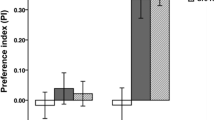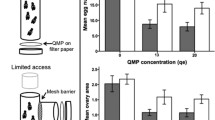Abstract
In this study we test one central prediction from sociogenomic theory—that social and non-social taxa share common genetic toolkits that regulate reproduction in response to environmental cues. We exposed Drosophila females of rover (for R) and sitter (for s) genotypes to an ovary-suppressing pheromone derived from the honeybee Apis mellifera. Surprisingly, queen mandibular pheromone (QMP) affected several measures of fitness in flies, and in a manner comparable to the pheromone’s normal effect on bee workers. QMP-treated sitter flies had smaller ovaries that contained fewer eggs than did untreated controls. QMP-treated rover flies, by contrast, showed a more variable pattern that only sometimes resulted in ovary inhibition, while a third strain of fly that contains a sitter mutant allele in a rover background (for s2) showed no ovarian response to QMP. Taken together, our results suggest that distinctly non-social insects have some capacity to respond to social cues, but that this response varies with fly genotype. In general, the interspecific response is consistent with a conserved gene set affecting reproductive physiology. The differential response among strains in particular suggests that for is itself important for modulating the fly’s pheromonal response.

Similar content being viewed by others
References
Amdam GV, Csondes A, Fondrk MK, Page RE Jr (2006) Complex social behaviour derived from maternal reproductive traits. Nature 439(7072):76–78
Amdam GV, Omholt SW (2003) The hive bee to forager transition in honeybee colonies: the double repressor hypothesis. J Theor Biol 223(4):451–464
Backx AG, Guzmán-Novoa E, Thompson GJ (2012) Factors affecting ovary activation in honey bee workers: a meta-analysis. Insect Soc 59:381–388
Belay AT, Scheiner R, So AK, Douglas SJ, Chakaborty-Chatterjee M, Levine JD, Sokolowski MB (2007) The foraging gene of Drosophila melanogaster: spatial-expression analysis and sucrose responsiveness. J Comp Neurol 504(5):570–582
Ben-Shahar Y, Robichon A, Sokolowski MB, Robinson GE (2002) Influence of gene action across different time scales on behavior. Science 296(5568):741–744
Bloch G, Grozinger CM (2011) Social molecular pathways and the evolution of bee societies. Philos T R Soc B 366(1574):2155–2170
Bourke AF (2011) The validity and value of inclusive fitness theory. Proc R Soc B 278(1723):3313–3320
Burns JG, Svetec N, Rowe L, Mery F, Dolan MJ, Boyce WT, Sokolowski MB (2012) Gene-environment interplay in Drosophila melanogaster: chronic food deprivation in early life affects adult exploratory and fitness traits. Proc Natl Acad Sci U S A 109(Suppl 2):17239–17244
Camiletti AL, Percival-Smith A, Thompson GJ (2013) Honey bee queen mandibular pheromone inhibits ovary development and fecundity in a fruit fly. Entomol Exp Appl 147:262–268
Crozier RH, Pamilo P (1996) Evolution of social insect colonies: sex allocation and kin selection. Oxford University Press, New York
de Belle JS, Hilliker AJ, Sokolowski MB (1989) Genetic localization of foraging (for): a major gene for larval behavior in Drosophila melanogaster. Genetics 123(1):157–163
Drapeau MD, Albert S, Kucharski R, Prusko C, Maleszka R (2006) Evolution of the yellow/major royal jelly protein family and the emergence of social behavior in honey bees. Genome Res 16(11):1385–1394
Eban-Rothschild A, Bloch G (2012) Social influences on circadian rhythms and sleep in insects. Adv Genet 77:1–32
Fitzpatrick MJ, Ben-Shahar Y, Smid HM, Vet LEM, Robinson GE, Sokolowski MB (2005) Candidate genes for behavioural ecology. Trends Ecol Evol 20(2):96–104
Fussnecker BL, McKenzie AM, Grozinger CM (2011) cGMP modulates responses to queen mandibular pheromone in worker honey bees. J Comput Physiol A Neuroethol Sense Neural Behav Physiol 197(9):939–948
Haydak MH (1970) Honey bee nutrition. Annu Rev Entomol 15:143-&
Ihle KE, Page RE, Frederick K, Fondrk MK, Amdam GV (2010) Genotype effect on regulation of behaviour by vitellogenin supports reproductive origin of honeybee foraging bias. Anim Behav 79(5):1001–1006
Jackson JT, Tarpy DR, Fahrbach SE (2011) Histological estimates of ovariole number in honey bee queens, Apis mellifera, reveal lack of correlation with other queen quality measures. J Insect Sci 11(82)
Johnson BR, Linksvayer TA (2010) Deconstructing the superorganism: social physiology, groundplans, and sociogenomics. Q Rev Biol 85(1):57–79
Kamakura M (2011) Royalactin induces queen differentiation in honeybees. Nature 473(7348):478–483
Kaun KR, Riedl CA, Chakaborty-Chatterjee M, Belay AT, Douglas SJ, Gibbs AG, Sokolowski MB (2007) Natural variation in food acquisition mediated via a Drosophila cGMP-dependent protein kinase. J Exp Biol 210(Pt 20):3547–3558
Keller L, Nonacs P (1993) The role of queen pheromones in social insects: queen control or queen signal? Anim Behav 45(4):787–794
Kent CF, Daskalchuk T, Cook L, Sokolowski MB, Greenspan RJ (2009) The Drosophila foraging gene mediates adult plasticity and gene-environment interactions in behaviour, metabolites, and gene expression in response to food deprivation. PLoS Genet 5(8):e1000609
King RC (1970) Ovarian development in Drosophila melanogaster. Academic, New York
Kocher SD, Richard FJ, Tarpy DR, Grozinger CM (2009) Queen reproductive state modulates pheromone production and queen–worker interactions in honeybees. Behav Ecol 20(5):1007–1014
Larsson MC, Domingos AI, Jones WD, Chiappe ME, Amrein H, Vosshall LB (2004) Or83b encodes a broadly expressed odorant receptor essential for Drosophila olfaction. Neuron 43(5):703–714
Michener CD (1974) The social behavior of the bees; a comparative study. Belknap, Harvard University Press, Cambridge, Mass
Mutti NS, Wang Y, Kaftanoglu O, Amdam GV (2011) Honey bee PTEN—description, developmental knockdown, and tissue-specific expression of splice-variants correlated with alternative social phenotypes. PLoS One 6(7):e22195
Osborne KA (1997) Natural behavior polymorphism due to a cGMP-dependent protein kinase of Drosophila. Science 277(5327):834–836
Page RE Jr, Amdam GV (2007) The making of a social insect: developmental architectures of social design. Bioessays 29(4):334–343
Page RE, Linksvayer TA, Amdam GV (2009) Social life from solitary regulatory networks: a paradigm for insect sociality. In: Gadau J, J. F (eds) Organization of insect societies, from genome to sociocomplexity. Harvard University Press Cambridge MA, pp 357–367
Pankiw T, Winston ML, Plettner E, Slessor KN, Pettis JS, Taylor OR (1996) Mandibular gland components of European and Africanized honey bee queens (Apis mellifera L.). J Chem Ecol 22(4):605–615
Pereira HS, Sokolowski MB (1993) Mutations in the larval foraging gene affect adult locomotory behavior after feeding in Drosophila melanogaster. Proc Natl Acad Sci U S A 90(11):5044–5046
Riedl CA, Neal SJ, Robichon A, Westwood JT, Sokolowski MB (2005) Drosophila soluble guanylyl cyclase mutants exhibit increased foraging locomotion: behavioral and genomic investigations. Behav Genet 35(3):231–244
Ruppell O, Pankiw T, Page RE Jr (2004) Pleiotropy, epistasis and new QTL: the genetic architecture of honey bee foraging behavior. J Hered 95(6):481–491
Slessor KN, Kaminski LA, King GGS, Borden JH, Winston ML (1988) Semiochemical basis of the retinue response to queen honey bees. Nature 332(6162):354–356
Smith CR, Toth AL, Suarez AV, Robinson GE (2008) Genetic and genomic analyses of the division of labour in insect societies. Nat Rev Genet 9(10):735–748
Sokolowski MB (2001) Drosophila: genetics meets behaviour. Nat Rev Genet 2(11):879–890
Thompson GJ, Kucharski R, Maleszka R, Oldroyd BP (2008) Genome-wide analysis of genes related to ovary activation in worker honey bees. Insect Mol Biol 17(6):657–665
Toth AL, Robinson GE (2007) Evo-devo and the evolution of social behavior. Trends Genet 23(7):334–341
Velarde RA, Robinson GE, Fahrbach SE (2006) Nuclear receptors of the honey bee: annotation and expression in the adult brain. Insect Mol Biol 15(5):583–595
Vijendravarma RK, Narasimha S, Kawecki TJ (2012) Evolution of foraging behaviour in response to chronic malnutrition in Drosophila melanogaster. Proc R Soc B 279(1742):3540–3546
Visscher PK (1989) A quantitative study of worker reproduction in honey bee colonies. Behav Ecol Sociobiol 25(4):247–254
Wang Y, Kocher SD, Linksvayer TA, Grozinger CM, Page RE Jr, Amdam GV (2012) Regulation of behaviorally associated gene networks in worker honey bee ovaries. J Exp Biol 215(Pt 1):124–134
West-Eberhard MJ (1996) Wasp societies as microcosms for the study of development and evolution In: S. Turillazzi MJW-E (ed) Natural History and Evolution of Paper Wasps. Oxford University Press, New York, pp 290–317
Acknowledgments
We thank Dr. Marla Sokolowski (University of Toronto) for the gift of rover and sitter flies, and for commenting on an earlier version of the manuscript. We also thank Emma Mullen and Catherine Gao from the Social Biology Group at Western University for help and discussion. This work was funded by an Ontario Graduate Scholarship to A.L.C. and a Natural Sciences and Engineering Research Council of Canada Discovery Grant to G.J.T.
Author information
Authors and Affiliations
Corresponding author
Additional information
Communicated by: Sven Thatje
Rights and permissions
About this article
Cite this article
Camiletti, A.L., Awde, D.N. & Thompson, G.J. How flies respond to honey bee pheromone: the role of the foraging gene on reproductive response to queen mandibular pheromone. Naturwissenschaften 101, 25–31 (2014). https://doi.org/10.1007/s00114-013-1125-3
Received:
Revised:
Accepted:
Published:
Issue Date:
DOI: https://doi.org/10.1007/s00114-013-1125-3




